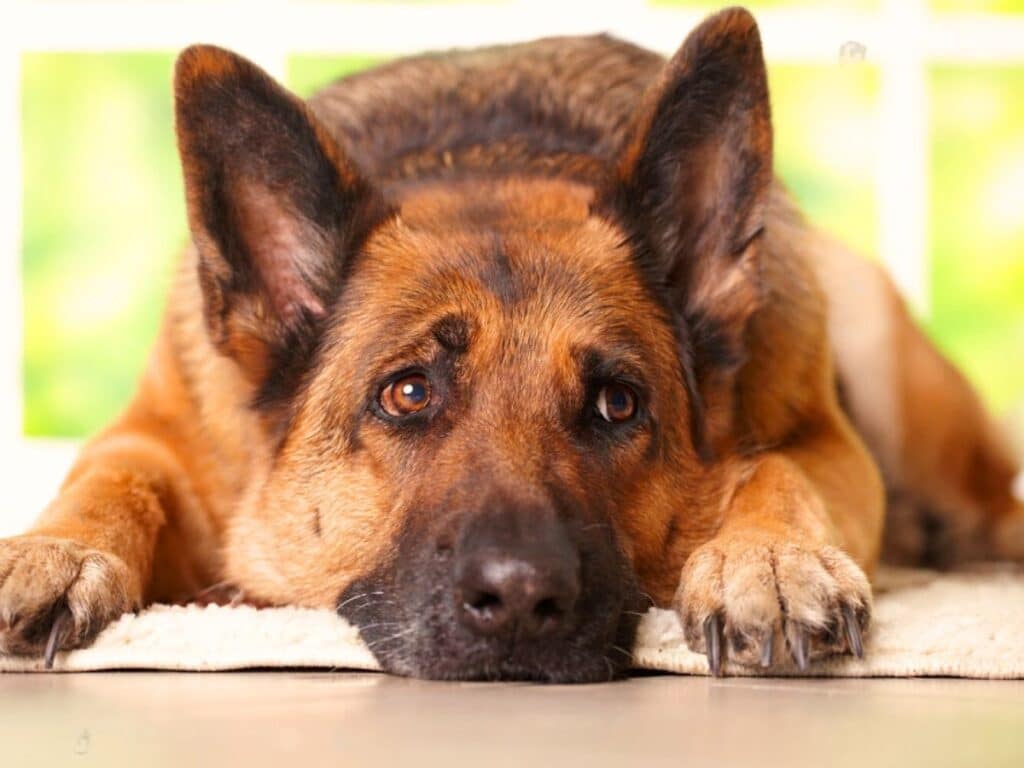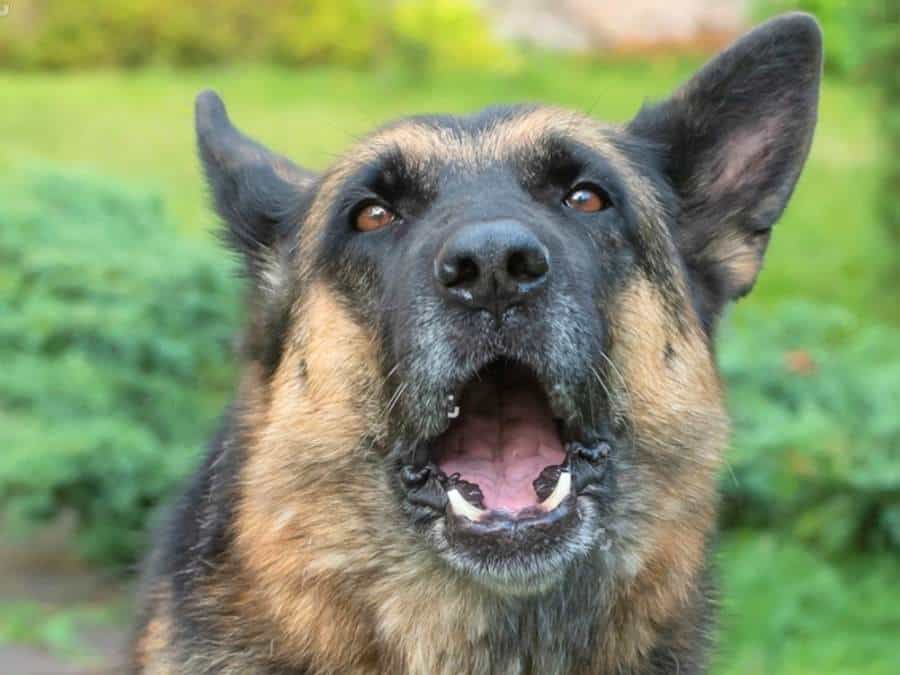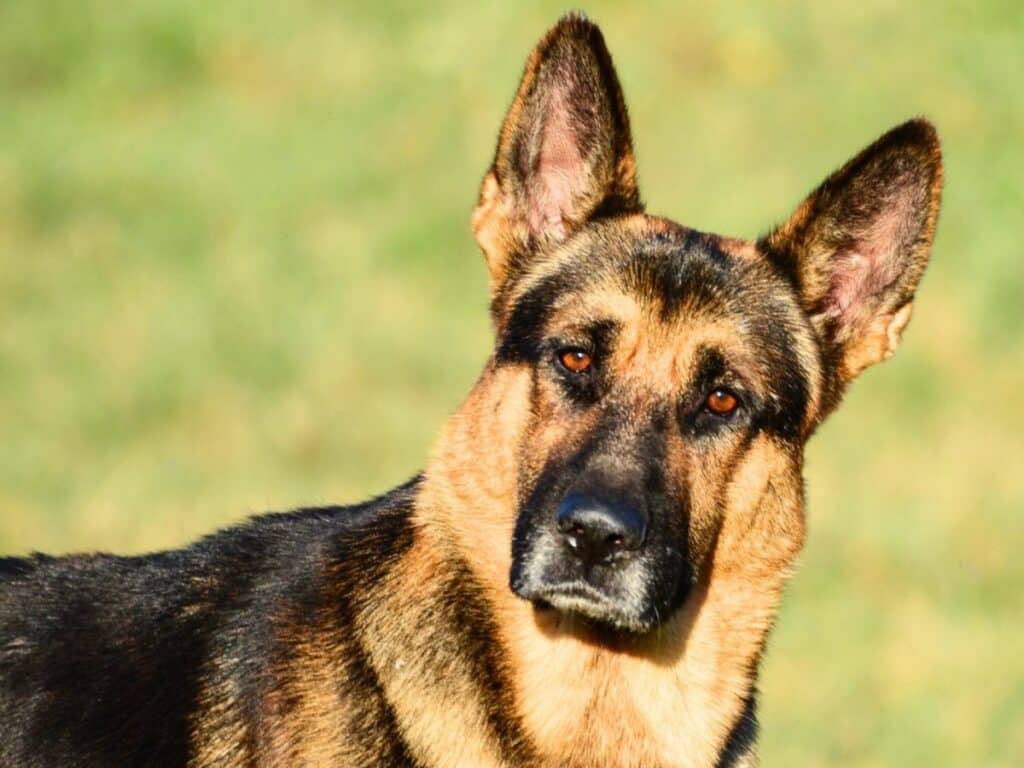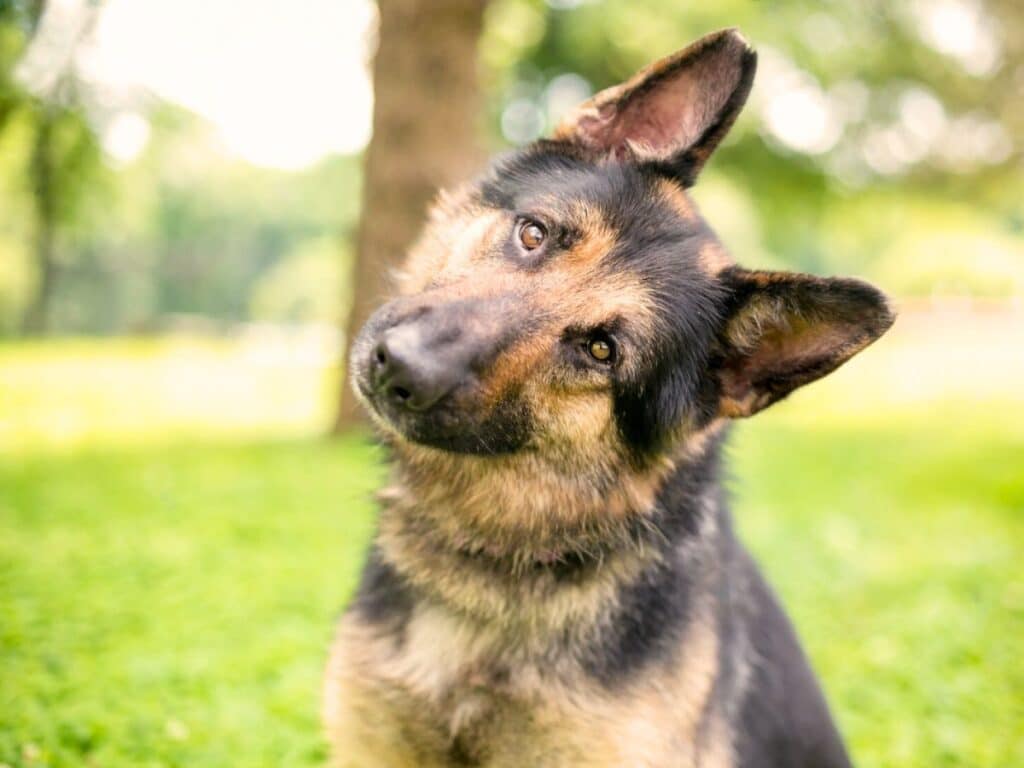If your German Shepherd is experiencing separation anxiety, life can be miserable both for you and your pup. I myself spent a whole year battling extreme separation anxiety with my second GSD Rocky, and we successfully came out on the other side.
So, In this article, I’ll share some of the tips and strategies that helped my dog feel better about being alone at home.
What is Separation Anxiety?
Separation anxiety is when a dog becomes distressed when left alone, even for short periods of time. (Source)
When your GSD is experiencing separation anxiety, it is quite similar to a panic attack in a human.
Imagine someone terrified of heights standing on the edge of a cliff – they might get sweaty hands, a dry mouth, and a fast heartbeat.
In the same way, every time a German Shepherd who has separation anxiety is left alone, their bodies are flooded with the same stress hormones.
Separation anxiety is not just your German Shepherd being dramatic and showing you how much they love you.
It’s a real disorder that is considered a medical emergency and should be taken seriously.
German Shepherd Separation Anxiety Symptoms
Common signs of separation anxiety in German Shepherds include:
- Excessive barking, howling, or whining when left alone.
- Chewing furniture, shoes, or other objects in the home.
- Inappropriate urination or defecation indoors, even if the dog is usually house-trained.
- Trying to escape from the confined area, crate, or room to reunite with the owner.
- Restless behavior, such as pacing or circling, often in response to the owner’s departure.
- Increased drooling, shaking, and panting due to stress and anxiety.
- Appearing sad or lethargic when the owner is about to leave or has already left.
- Lack of interest in food, especially when left alone.
- Clingy behavior, constantly following the owner from room to room.
- Overly enthusiastic greeting upon the owner’s return, even after a short absence.
- Digging at doors, windows, or the floor in an attempt to escape or reach the owner.
Depending on the severity of a German Shepherd’s separation anxiety, the symptoms may vary.
If left untreated, separation anxiety can escalate and you might notice more extreme signs as time goes on.
RELATED: What To Do With German Shepherd While at Work?

What Causes Separation Anxiety in German Shepherds?
The exact cause of separation anxiety in GSDs is not always clear-cut, as it can result from a combination of genetic, environmental, and situational factors.
Some common causes and contributing factors include:
- Early trauma or loss: Dogs that have experienced traumatic events, such as being abandoned or losing a significant caregiver, may be more prone to separation anxiety.
- Changes in routine: Sudden changes in the dog’s routine, such as a change in the owner’s schedule, moving to a new home, or the addition of a new family member, or a death can trigger anxiety.
- Lack of socialization: Dogs that have not been adequately socialized or have had limited exposure to various environments, people, and other animals may be more susceptible to separation anxiety.
- Breed predisposition: German Shepherds are more prone to developing separation anxiety because they are highly social and tend to form strong bonds with their owners.
- Owner changes: If a dog is rehomed or adopted, it may experience anxiety due to the change in ownership.
- Overdependence on the owner: Dogs that are overly dependent on their owners and lack independence may struggle when left alone.
- Lack of mental & physical stimulation: GSDs need mental and physical exercise. Lack of stimulation can lead to boredom and anxiety, especially when left alone.
- Negative experiences: A dog may associate being alone with negative experiences, such as punishment or traumatic events.
- Lack of training: Dogs that haven’t been properly trained to tolerate being alone may develop separation anxiety.
It’s important to note that not all German Shepherds will develop separation anxiety, even if they experience one or more of these factors. Additionally, individual differences and temperamental factors play a role.
RELATED:

How To Fix Your German Shepherd’s Separation Anxiety
Addressing and managing a dog’s separation anxiety typically involves a combination of behavior modification, environmental adjustments, and sometimes medication.
Here are some strategies that helped me deal with my GSD’s separation anxiety :
1. Behavior modification through gradual desensitization
Gradual desensitization is a behavior modification technique that involves exposing a dog to the source of anxiety (being left alone, in the case of separation anxiety) in a gradual and controlled manner.
German Shepherd Separation Anxiety Training
- Begin by practicing very short departures that don’t trigger anxiety. This could be as simple as stepping out of sight for a few seconds and then returning.
- Repeat this process multiple times throughout the day.
- Gradually extend the duration of your departures in small increments. For example, go from a few seconds to 10 seconds, then to 30 seconds, and so on.
- Only progress to the next duration when the dog remains calm and shows no signs of distress.
- Your GSD may start to get nervous when they see signs you’re about to leave, like putting on your shoes or picking up your keys. So do those things, but then don’t leave.
- Put on your shoes and then sit down at the table. Pick up your keys and watch TV.
- Do this over and over many times a day. This helps prevent the dog from associating specific actions (e.g., picking up keys) with your departure, which can trigger anxiety.
- When you return, reward your dog for calm behavior. Use treats, praise, or play to reinforce the positive experience of your return.
- This helps create a positive association between your departures and the reward that follows.
Gradual desensitization works best when combined with the following strategies.
2. Make arrivals and departures low-key
Dogs often pick up on cues signaling the departure of their owners, which can trigger anxiety. By keeping arrivals and departures calm and uneventful, you help mitigate the emotional intensity surrounding these moments.
Avoid prolonged goodbyes or overly enthusiastic greetings, as these can heighten a dog’s anticipation and anxiety. Instead, enter and leave the house without making a fuss, refraining from dramatic gestures or prolonged eye contact.
This approach helps to downplay the significance of your comings and goings, reducing the stress associated with separation.
RELATED: Why Is My German Shepherd So Hyper? 10 Tips To Calm Them
3. Create a safe space for them where they can rest when home alone
This designated area, whether it’s a specific room or a comfortable crate, provides a secure and familiar environment for your dog when you’re not at home.
Furnish the space with your dog’s favorite toys, a cozy bed, and items that carry your scent. This safe haven serves as a retreat where your dog can feel protected and calm.
The enclosed space can prevent destructive behaviors triggered by anxiety, offering a controlled environment to help your dog cope with being alone.

4. Exercise your GSD
Physical activity helps expend excess energy, making a dog more relaxed and less prone to anxiety when left alone.
Engaging in activities like daily walks, play sessions, and interactive games not only promotes physical well-being but also contributes to a healthier mental state.
Mental stimulation is equally important, as it keeps a dog’s mind engaged and prevents boredom.
Puzzle toys, training sessions, and activities that challenge their cognitive abilities can be effective in redirecting focus and providing a positive outlet for mental energy.
5. Counterconditioning
During counterconditioning, departures are coupled with enjoyable experiences, such as treats, toys, or engaging activities.
For instance, giving your dog a special treat just before leaving and providing an interactive toy can create positive anticipation.
The positive reinforcement helps the dog associate your departure with pleasurable outcomes, gradually reducing anxiety.
Consistency is key in implementing counterconditioning, and over time, the dog may come to view alone time as less threatening and more enjoyable.
6. Seek professional help
Veterinarians and certified dog behaviorists possess the expertise to assess the severity of the anxiety and provide tailored guidance.
A professional evaluation helps rule out underlying health issues and ensures an accurate diagnosis of separation anxiety.
Behaviorists can develop comprehensive behavior modification plans, incorporating strategies like desensitization and counterconditioning, specific to the individual dog’s needs.
In more severe cases, medication prescribed by a veterinarian may be recommended to complement behavioral interventions.
RELATED: German Shepherd Depression Symptoms
Products To Help a German Shepherd With Separation Anxiety
Here are some products available on Amazon that may help manage separation anxiety in your German Shepherd:
1. Pawsential Advanced Dog Calming Chews

These chews are designed to address symptoms related to stress in dogs, such as hyperactivity, excessive barking, nervousness, and aggressive behaviors. By promoting relaxation without sedation, these chews aim to alleviate stress-related behaviors in a natural and non-invasive way.
Buy Pawsential Dog Calming Chews on Amazon
2. Furbo 360° Rotating Smart Dog Camera Treat Dispenser

This device’s smart camera not only allows you to monitor your dog remotely but also features a treat dispenser that can be rotated to dispense treats for your pet. With the ability to see, hear, and reward your dog from a distance, this device offers a way to engage and alleviate separation anxiety.
Buy Furbo 360° Smart Dog Camera on Amazon
3. ThunderShirt Classic Dog Anxiety Jacket

The ThunderShirt Classic Dog Anxiety Jacket is specially designed to apply gentle and constant pressure to a dog’s torso, providing a sense of security and comfort. This pressure simulates the feeling of a reassuring hug, which can have a calming effect on dogs experiencing anxiety, fear, or overexcitement.
Buy ThunderShirt Anxiety Jacket on Amazon
4. ThunderEase Dog Calming Pheromone Diffuser

The ThunderEase Dog Calming Pheromone Diffuser is designed to create a calming environment for dogs by mimicking the natural pheromones that dogs release. These pheromones convey a sense of comfort and security, making them effective in reducing stress and anxiety-related behaviors.
Buy ThunderEase Pheromone Diffuser on Amazon
5. Lick Mat for Dogs

The mat typically features a textured surface that dogs can lick, encouraging natural licking behaviors that promote relaxation and alleviate anxiety. The addition of suction cups allows the mat to be securely attached to various surfaces, turning it into an engaging and interactive tool.
6. Calming Collar for Dog Anxiety Relief

A Calming Collar is a wearable solution designed to help alleviate stress and anxiety in dogs. They are typically infused with pheromones that imitate the pheromone of the puppy’s mother and can have a calming effect on dogs. The continuous exposure to these calming aromas provides a non-intrusive and drug-free way to manage anxiety-related behaviors.

What Not To Do When Your GSD Has Separation Anxiety
When dealing with a GSD that has separation anxiety, there are certain actions you should avoid to prevent exacerbating the problem. Here’s a list of things not to do:
- Punishment: Avoid punishing your dog for behaviors related to separation anxiety. Punishment can increase stress and worsen anxiety.
- Excessive attention before leaving: Refrain from giving your dog excessive attention or creating a dramatic departure routine. This can heighten anxiety and make the departure seem like a big event.
- Comforting overly during returns: While it’s natural to want to comfort your dog when you return, avoid making a big fuss. This can reinforce the idea that your return is an extraordinary event and heighten anxiety during your absence.
- Ignoring the problem: Ignoring the signs of separation anxiety or assuming the behavior will improve on its own can lead to increased stress for your dog.
- Leaving for extended periods too soon: Gradually increase the time you spend away rather than leaving your dog alone for extended periods too quickly. Sudden and prolonged absences can intensify anxiety.
- Making departures and arrivals predictable: Try not to create a predictable routine for departures and arrivals, as this can contribute to anxiety.
- Getting another pet on a whim: While introducing a companion animal can help in some cases, getting another pet without proper consideration or preparation may not solve the problem and could lead to new challenges.
- Leaving unprepared: Don’t leave your dog unprepared for your departure. Ensure they have a safe and comfortable space with toys and activities to keep them occupied.
- Ignoring behavioral changes: If you notice behavioral changes related to separation anxiety, don’t dismiss them. Address the issue promptly with appropriate training and behavior modification.
If the separation anxiety persists, don’t skip professional guidance. Consulting with a veterinarian or professional dog trainer can provide valuable insights and a tailored plan for managing the issue.
Summary
Consistency and patience are key as you work towards alleviating your German Shepherd’s separation anxiety. Establishing a daily routine, obedience training, gradual alone time techniques, exercise, and calming methods are all valuable tools. Remember to avoid reinforcing anxious behaviors and seek professional help for severe cases. By implementing these strategies, you can help your German Shepherd feel more secure and content when left alone.
FURTHER READING:




